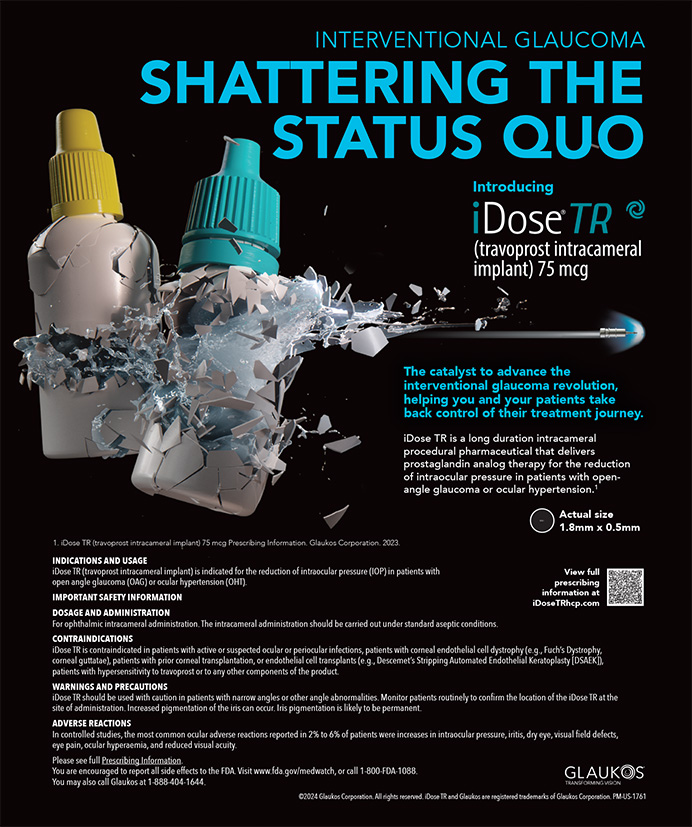As cataract surgery becomes more technologically advanced and patients' expectations soar, it is more important than ever for surgeons to achieve the target refraction—usually emmetropia. Because one of the biggest causes of patients' dissatisfaction with presbyopia-correcting IOLs is residual astigmatism, ophthalmologists have become aggressive about treating even 0.50 D of keratometric astigmatism. Modern surgeons employ a combination of femtosecond lasers and diamond blades along with advanced nomograms for creating limbal relaxing incisions (LRIs) at the time of cataract surgery in an attempt to obtain for each patient his or her best possible visual acuity. In this case, the effort to maximize the refractive outcome could have had a disastrous end.
INITIAL SURGERY AND OUTCOME
A 65-year-old man with cataracts underwent uncomplicated surgery on his right eye and then, a week later, on his left. Each eye received a single nasal LRI to address againstthe- rule astigmatism.
An examination of the patient's left eye 1 day after surgery showed nothing out of the ordinary. His visual acuity was 20/25 OS, but there was slight, deep corneal stromal haze present at one end of the LRI. The examining doctor noted the finding but did not consider it to be a true infiltrate and thus elected to observe the patient. He was using moxifloxacin drops four times a day.
During the examination on postoperative day 5, the patient complained of foreign body sensation. Two small (1 × 1 mm), deep stromal infiltrates were evident at either end of the LRI in his left eye with overlying epithelial defects. The patient was referred for a corneal consultation.
CULTURE RESULTS
I opened the LRI using a blunt cannula and obtained cultures from the LRI bed. Given the bed's extreme thinness and the potential weakening of the tissue due to the infiltration of inflammatory cells, I was especially careful when obtaining the specimen. I started the patient on hourly topical vancomycin 50 mg/mL fortified ophthalmic drops. On the following day, the cultures came back positive for Staphylococcus aureus; later sensitivities would show this to be methicillin-resistant S aureus.
TREATMENT
I saw the patient every few days to open and gently abrade the incision with a fine Dacron swab in order to enhance the delivery of the antibiotics. His visual acuity was 20/25 at all of these visits. By postoperative day 15, there was scarring and resolution of the infiltrate along with closure of the epithelial defect. Vancomycin was tapered to four times a day for 10 more days.
The patient returned on postoperative day 40 with a new infiltrate at one end of the LRI, again in the deep corneal stroma; localized injection with foreign body sensation; and a visual acuity of 20/30 OS. I reopened the incision and recultured the bed. In addition to increasing the vancomycin drops to hourly, I prescribed oral bacitracin DS and bacitracin ophthalmic ointment at bedtime. The cultures remained negative, and within 10 days (postoperative day 50), this area scarred in again with no evidence of an active infiltrate. The eye maintained mild injection but was otherwise quiet, and the patient's visual acuity returned to 20/25 (Figure). Bacitracin DS was administered for 10 days, and after the clinical improvement was noted, vancomycin was gradually tapered over a 2-week period to four times daily.
DISCUSSION
Infectious keratitis after an LRI is an uncommon event but one with potentially serious consequences. My colleagues and I previously had a case of Mycobacterium chelonae in an LRI that resulted in a 6-month battle ultimately leading to enucleation. In this case, early clinical signs implied an acute bacterial infection typical of the Staphylococcus and Streptococcus genera. Although the identity of the organism was quickly discovered and appropriate antibiotics were begun, drug delivery to the deep corneal stroma is problematic. This challenge might be what led to the clinical recurrence despite apparent resolution.
This case also highlights the Achilles' heel of fluoroquinolone therapy: grampositive organisms. Although fourth-generation fluoroquinolones are capable of extremely broad coverage and good tissue penetration, their coverage of Staphylococcus genus is incomplete.1
As they perform more and more LRIs in an attempt to correct their patients' visual acuity as completely as possible, surgeons can expect to see more complications of this relatively safe form of therapy. If infectious keratitis is suspected after an LRI in a patient on broad-spectrum therapy, a further and immediate broadening of the antibiotic spectrum is indicated with intensive topical therapy. The time to perforation can be short due to the depth of the infection; LRIs are not really effective unless they are at least 500 μm deep. I recommend culturing on multiple media (blood agar, chocolate agar, thioglycolate broth, Sabouraud dextrose agar) and adding specialized media (such as Lowenstein-Jensen agar), especially if the presentation of the infection is delayed, as this implies more indolent, harderto- culture organisms such as atypicals (ie, acid fast or Gram indeterminate) and mycobacteria. Sometimes, stains (Gram and Giemsa) can help guide therapy prior to culture positivity.
Frequent opening and debridement of the incision may assist drug delivery, and oral therapy can be considered, particularly if there is close proximity to the limbal vasculature. With aggressive therapy, ophthalmologists can reduce the risk that a case of keratitis after an LRI will threaten an otherwise perfect surgical result.
William J. Lahners, MD, is the medical director and director of Laser Vision Services at Center for Sight in Sarasota, Florida. Dr. Lahners may be reached at (941) 925-2020; wjlahners@centerforsight.net.
- The Charles T. Campbell Eye Microbiology Lab, University of Pittsburgh Schools of the Health Sciences. Antibiotic susceptibility: keratitis. http://eyemicrobiology.upmc.com/AntibioticSusceptibilities/Keratitis.htm. Accessed March 21, 2013. Accessed March 21, 2013.


